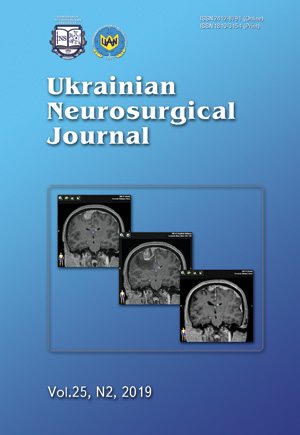Pain and weakness in hand: Differential diagnosis between cervical radiculopathy and brachial plexopathy
DOI:
https://doi.org/10.25305/unj.155716Keywords:
brachial plexopathy, cervical radiculopathy, diagnostics, electromyographyAbstract
The lecture is dedicated to the topical problem of neurology — differential diagnosis between cervical radiculopathy and brachial plexopathy. The basic principles and steps of clinical diagnostics, possibilities, and stages of electrophysiological diagnosis of the functionality of the cervical root and trunk of the shoulder plexus are considered.
The purpose of the first stage of diagnostics is to determine the origin of the pain syndrome: whether it has a neurogenic nature, or is the aftereffect of the damage to the locomotor system. In the case of neurogenic pathology, the task of the second stage is a clear verification of C5, C6, C7, C8, T1 radiculopathy by evaluating the maximum measurements of motor and sensory nerves originating from a particular root. Accordingly, the differential diagnosis of brachial plexopathy, thoracic outlet syndrome, and mononeuropathy of the nerves of the arm is also based on strict observation of the peculiarities of their location.
There were analyzed the opportunities of various methods of electrophysiological diagnostics, namely, stimulation and needle electromyography in solving the problems of topical diagnosis are outlined, as well the evidence of using the method of electromyographic paraspinal mapping at the cervical level for the differential diagnosis between plexopathy and radiculopathy. However, it is maintained that the attending physician should establish the nosological diagnosis. The article presents the clinical cases and restrictions of electromyographic diagnostics in the differentiation of controversial issues. The material of the lecture is based on the review of a significant number of neurosurgical, neurological and orthopedic sources; the author also included the results of her own research performed over the past 20 years including those carried out during the neurosurgery follow-up of about 300 patients.
References
1. Daube JR, Dillingham TR, Donofrio PD, Robinson LR. Numbness, Tingling, and Pain: A Basic Approach to Electrodiagnostic Medicine. Rochester: American Association of Neuromuscular & Electrodiagnostic Medicine; 2010. https://pdfs.semanticscholar.org/6320/d1cf55553f6656ccb00e48bde182051251df.pdf
2. Feldman EL, Grisold V, Russell DV, Lesher VN. Atlas of Neuromuscular Diseases: A Practical Guide. Translation from English. Moscow: Prakticheskaya meditsina; 2016
3. Mumentaler M, Shtor M, Müller-Fall G. Peripheral nerve lesions and radicular syndromes. Translation from English. Moscow: MEDpress-inform; 2013.
4. Juel VC. Electrophysiologic Testing in Neuromuscular Weakness. In: Basics With the Experts. Rochester: American Association of Neuromuscular & Electrodiagnostic Medicine; 2013. P. 21-24. https://pdfs.semanticscholar.org/bbf5/f537d8fd5faf616d795535ffed4005f87649.pdf
5. Rubin DI. Daube JR. Clinical Neurophysiology. 4th ed. Oxford University Press; 2016.
6. Grana EA. Cervical radiculopathy/brachial plexopathy. Rochester: American Association of Neuromuscular & Electrodiagnostic Medicine; 2005. https://pdfs.semanticscholar.org/5b1d/fbce037975b9917549c74aa740f1bb7df430.pdf
7. Dillingham TR. Evaluating the patient with suspected radiculopathy. PM R. 2013 May;5(5 Suppl):S41-9. [CrossRef] [PubMed]
Downloads
Published
How to Cite
Issue
Section
License
Copyright (c) 2019 Albina I. Tretiakova

This work is licensed under a Creative Commons Attribution 4.0 International License.
Ukrainian Neurosurgical Journal abides by the CREATIVE COMMONS copyright rights and permissions for open access journals.
Authors, who are published in this Journal, agree to the following conditions:
1. The authors reserve the right to authorship of the work and pass the first publication right of this work to the Journal under the terms of Creative Commons Attribution License, which allows others to freely distribute the published research with the obligatory reference to the authors of the original work and the first publication of the work in this Journal.
2. The authors have the right to conclude separate supplement agreements that relate to non-exclusive work distribution in the form of which it has been published by the Journal (for example, to upload the work to the online storage of the Journal or publish it as part of a monograph), provided that the reference to the first publication of the work in this Journal is included.









